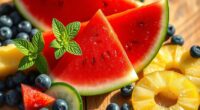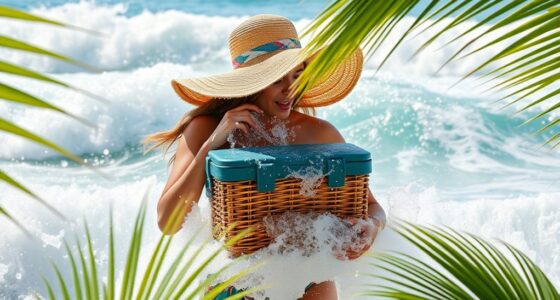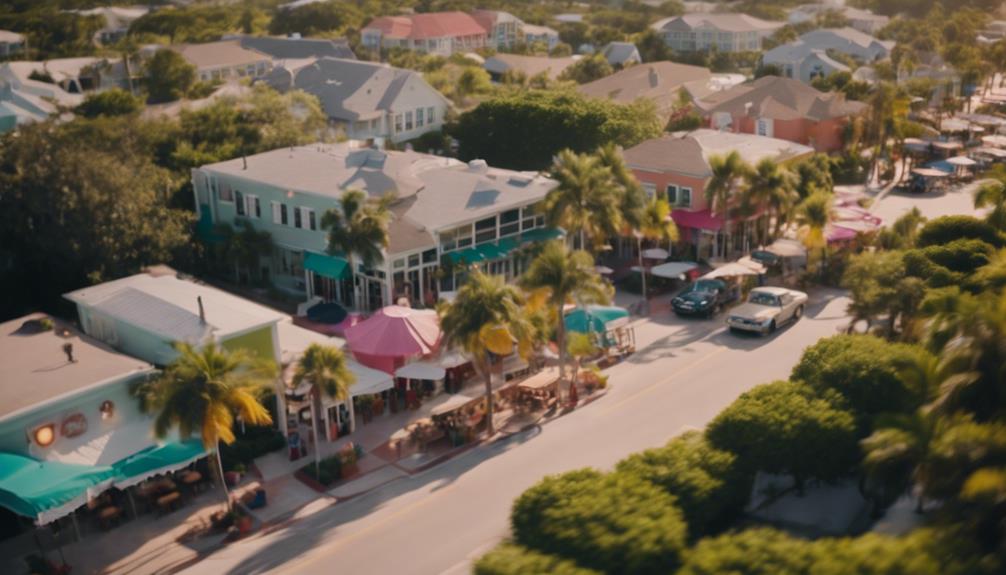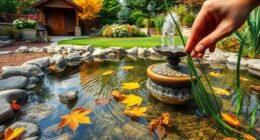If you want to forage edible coastal plants and seaweeds safely, start by identifying common varieties like kelp, nori, wakame, sea lettuce, samphire, and beach asparagus. Use scissors to harvest only what you need, rinse thoroughly, and avoid plants near polluted areas. Respect the environment by taking sustainably and verifying species to prevent toxicity. Exploring further will teach you how to harvest responsibly while enjoying nutritious, wild foods from your shoreline.
Key Takeaways
- Identify edible coastal plants like seaweed, sea lettuce, samphire, and beach asparagus by their appearance and growth patterns.
- Harvest seaweed carefully with scissors, taking only what’s needed to promote sustainable growth.
- Rinse harvested plants thoroughly in clean seawater to remove debris before consumption.
- Avoid collecting plants from polluted areas or damaged sites to ensure safety and environmental health.
- Practice responsible foraging by respecting ecosystems, using proper tools, and consulting local experts for accurate identification.

Coastal areas are rich with edible plants that many people overlook, offering a sustainable and nutritious food source. When you explore the shoreline, you’ll find a bounty of edible plants waiting to be harvested, especially seaweed and various beach plants. Learning how to identify and harvest these resources responsibly can expand your culinary options while connecting you to nature.
Seaweed harvesting is an excellent starting point for foragers. Different types of seaweed grow abundantly along rocky shores and tidal pools, and many are safe to eat. You’ll want to look for common varieties like kelp, nori, and wakame, which are often found attached to rocks or floating near the coastline. When harvesting seaweed, do so sustainably by taking only what you need and avoiding overharvesting from the same spot. Use scissors or scissors-like tools to cut the seaweed at the base, ensuring you leave enough behind for the plant to regenerate. Rinse it thoroughly in clean seawater to remove sand, debris, and small creatures before using it in your meals. Incorporating seaweed into salads, soups, or snacks not only boosts nutritional value but also adds a savory umami flavor that many find appealing.
Beach plant identification is another essential skill. Many edible plants grow along the shoreline, including sea lettuce, samphire, and beach asparagus. To identify these plants, pay attention to their distinctive features—such as leaf shape, color, and growth pattern. For example, samphire has succulent, bright green stems that are crunchy and salty, making it perfect for salads or as a cooked vegetable. Beach asparagus has slender, spear-like shoots that resemble terrestrial asparagus but thrive in salty environments. Always double-check your identification with reputable guides or local experts, as some coastal plants can resemble toxic varieties. When foraging, avoid plants growing near polluted areas or those with signs of damage, and always harvest in moderation.
Frequently Asked Questions
Are All Coastal Plants Safe to Eat?
Not all coastal plants are safe to eat. You should always consider plant toxicity and follow foraging ethics to avoid dangerous mistakes. Just because a plant grows near water doesn’t mean it’s edible; some are toxic and can cause serious illness. Always properly identify plants before consuming, use trusted guides, and respect local regulations. When in doubt, it’s safest to avoid eating unfamiliar coastal plants altogether.
How Do I Identify Edible Versus Poisonous Coastal Plants?
Ever wondered how to distinguish edible coastal plants from dangerous ones? You can identify edible plants by closely examining their leaves, stems, and flowers, comparing them with trusted guides. Always practice plant identification carefully, paying attention to details like smell, texture, and growth habits. Remember, toxicity awareness is vital—never eat a plant unless you’re 100% sure it’s safe. When in doubt, consult an expert or avoid consumption altogether.
Can I Harvest Coastal Plants Sustainably?
Yes, you can harvest coastal plants sustainably by practicing sustainable harvesting techniques. Always take only what you need, avoid overharvesting, and leave enough for the plant to regenerate. Respect local regulations and promote coastal plant conservation by not damaging the surrounding environment. By being mindful and responsible, you guarantee these valuable resources remain available for future foragers and support the health of coastal ecosystems.
What Tools Are Best for Foraging Coastal Plants?
Imagine wielding a modern paring knife, like a chef in a top kitchen, for precise harvesting. You’ll want sturdy, sharp scissors or pruning shears for safe and efficient foraging. A small digging tool helps with roots, while gloves protect your hands. Always prioritize harvesting techniques that promote plant health and foraging safety—use tools carefully to avoid damage and guarantee sustainable gathering. Proper tools make your coastal foraging both effective and responsible.
Are There Seasonal Restrictions for Foraging Edible Coastal Plants?
Yes, there are seasonal restrictions for foraging edible coastal plants. You should follow seasonal foraging guidelines because plant growth cycles vary throughout the year. During certain seasons, some plants are best harvested while others are protected to ensure sustainability. By paying attention to plant growth cycles, you can enjoy safe, sustainable foraging and avoid damaging the ecosystem. Always research local regulations and plant-specific harvesting times before you go.
Conclusion
Now that you’ve navigated nature’s nourishing nooks, you’re ready to forage freely and feast mindfully. Remember, with a little knowledge and keen eyes, you can confidently collect coastal crops that complement your culinary creations. Embrace the adventure, respect the environment, and enjoy the edible treasures hiding along the shoreline. So, step softly, scout smartly, and savor the spectacular, sustainable sustenance waiting just beyond the water’s edge. Happy foraging and happy feasting!










